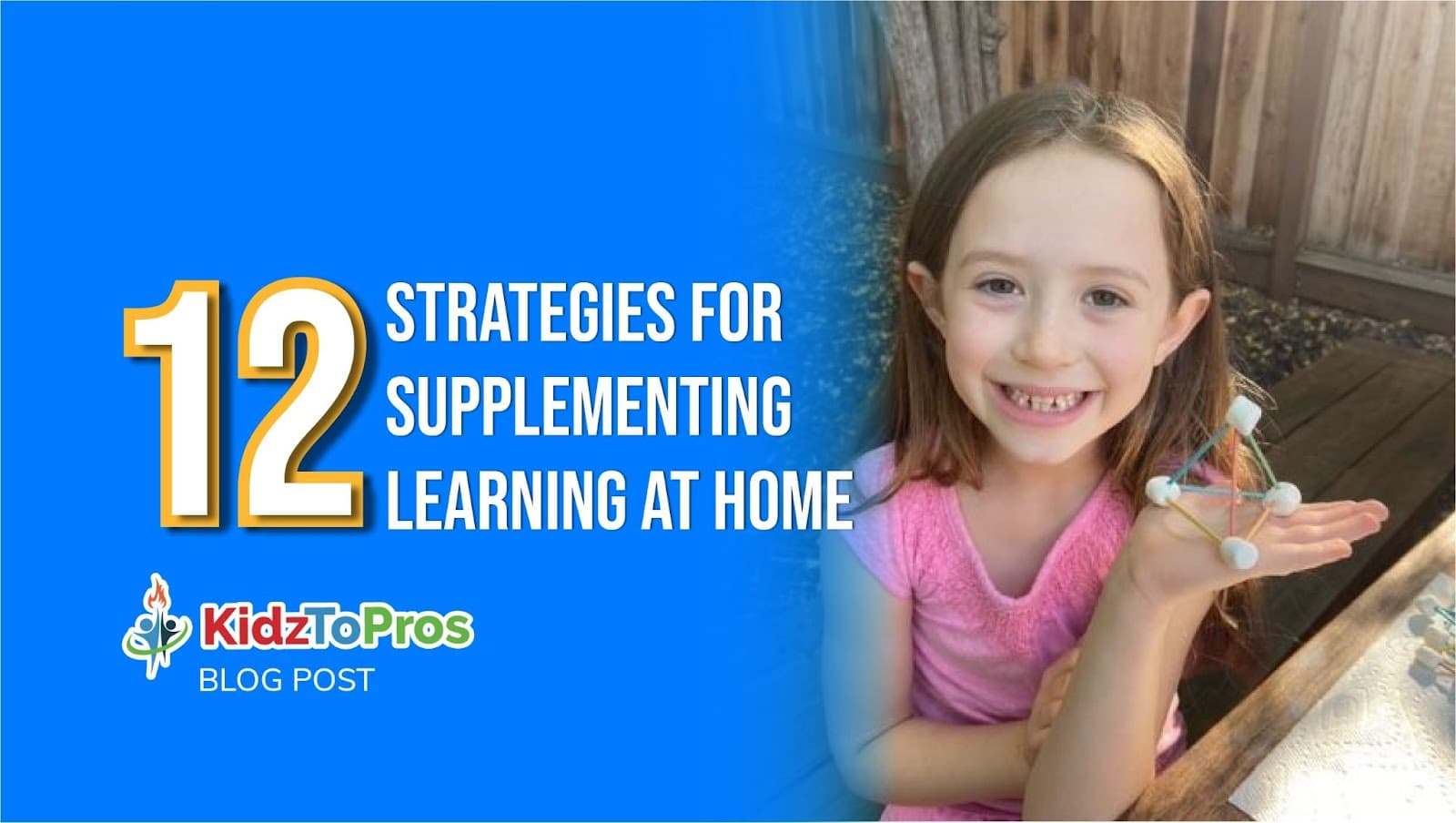12 Strategies for Supplementing Learning at Home

Do you know what your children are learning at school? It’s time to get involved in your students’ education by supplementing what they’re learning at home. You don’t need to be a teacher or know how to lesson plan to do that. All it takes is a few strategies to help you get going, tap into their interests, and bolster what they’re already being taught at school.
Supporting Your Students in Home Learning
Many parents fear they don’t have what it takes to teach their kids. Guess what? You’re not alone! Everyone wants their kids to succeed – and KidzToPros is here to help. If you get more involved in your students’ education, they can experience just how much you care.
We hope you’ll join hands with us and start supplementing your students’ learning at home. Let’s get started with the tips below.
Supplementing Learning at Home
Wherever your kids go to school, you can supplement their learning at home with these 12 simple strategies. Just remember to keep it fun and engaging for maximum results!
1. Know What They’re Learning in School
The more you connect with teachers and educators, the easier it’ll be to plan additional activities that extend their learning. Talk to instructors, let them know what you’re planning, and ask for strategies to help push your children forward.
2. Create a Space for Learning at Home
Taking each child’s personality into account, create a learning space where they can feel at home. A quiet room or corner with a desk, table or rug where they can spread out usually works best. Keep supplies organized and easily accessible. Let each child personalize their space to help make it their own, as well.
3. Get Involved in the Details
Involve the whole family in home learning. Research locations they’re learning about in school together. Learn different countries’ customs and traditions. Cook a meal of local food together. Listen to their popular music. Have kids make art projects demonstrating what they learn. These are all great ways to share hands-on learning experiences!
4. Expose Them to the World
Increase your students’ circle of influence as they learn from home. Take them on in-person or virtual field trips to museums, parks, cultural exhibits and events, zoos, nature centers and the like. They’ll learn about others and grow to appreciate the world around them.
5. Support School Projects at Home
If they’re learning about mammals in school, help small children choose a stuffed animal for show-and-tell. Allow older students to work on a science fair project that interests them. Little artists may enjoy painting your portrait. Strategies like these in home education help kids put into practice what they’re learning at school.
6. Utilize Online, Educational Resources
Many online educational sites offer free (or free trial) learning and games that replace passive screen time with active home learning time. Examples include ABCMouse, Khan Academy, Kahoot!, BrainPOP, Reading Eggs and Mathseeds. Each resource focuses on a different topic, from math or reading skills to science or social studies.
7. Assign Bridge Activities to Aid Learning at Home
Bridge activities connect children at their current educational levels with where they need to end up academically. If your child needs to gain math skills, assign them math activities in grade-level workbooks. If they struggle in reading or writing, teach them to research and write on topics of interest.
8. Keep Them Reading & Writing
First, read with your kids regularly. Second, take your kiddos on in-person and virtual library trips. Third, ask them to write about what they read. Fourth, take youngsters grocery shopping and ask them to read ingredient labels or cooking instructions. Home learning exercises like these can be invaluable!
9. Enlist Kids to Help at Home
Young people need to learn all kinds of life skills. Involving them in cooking, cleaning, shopping, home or car repairs, and caring for younger children teaches them to measure, tell time, problem-solve and innovate.
10. Play Educational Games
Get the whole family together and play cards. Create a trivia game, and teach your kids interesting facts. Pull out the puzzles and teach students to match patterns and colors. Show educational videos and have them make up silly questions about what they learned. Play board games and teach children how to budget their money in Monopoly, or support their family in the game of Life.
11. Use Educational Manipulatives
Manipulatives can be used for counting, making arts and crafts or learning about the earth. Most importantly, they teach kids to understand concepts when learning from home. You don’t need to buy expensive toys to challenge your kids academically. Consider using items you may already have on hand. Blocks, magnetic letters, dice, paperclips, small erasers, buttons, rocks, craft sticks and poker chips make excellent manipulatives.
12. Enroll Children in Community Classes, Camps or Afterschool Programs
Perhaps one of the best outlets for education and fun exists in your own neighborhood. Many community recreational centers offer classes like swimming, martial arts, cooking and dancing lessons for kids. Afterschool programs and summer camps hosted by companies like KidzToPros pull out all the stops with courses like digital arts, computer programming, improv comedy and filmmaking.
Making Learning at Home Easy & Fun
Your time with your kids is limited. Give them opportunities to have fun, enrich their education and enjoy learning at home. And, if you’re looking for support in the form of afterschool programs, give KidzToPros a chance to help. We’ve got STEM, arts and sports pathways that make learning fun.
Check them out – and sign up now!


